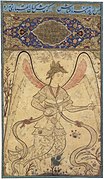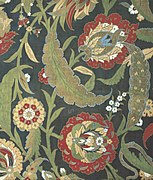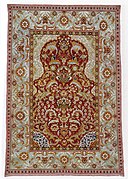Saz style

Saz style (Turk. saz yolu) is a style of vegetal ornament and an associated art style from the 16th-century Ottoman Empire.
Name and identity
Saz was a style of vegetal ornament popular in Ottoman decorative arts of the 16th century, characterized by the use of long, feathery sawtoothed leaves and composite blossoms.[4] At the same time, saz is also used as a name for the art style, in which saz ornament was basic element of the compositions.[5]
Contrary to the better known historical style of Ottoman painting saz style served no direct illustrative purpose, therefore might be described as lyrical. Its works are fantastic and virtuosic displays of technique using the saz qalami, or reed pen, that gave this group of works its name. Saz style is represented by two distinct groups of artistic products. The first "consists of album drawings, book illumination, and other works on paper; the second, derived from these paper images, includes virtually all the Ottoman decorative art forms, from bookbinding through textiles, carpets, metalwork, stonecarving, and ceramics"[6]
History
Saz style "in which mythical creatures derived from Chinese or Islamic sources move through an enchanted forest made up of oversized composite blossoms and feathery leaves, has parallels in the art of the
Although it started during the reign of
Gallery
-
Peri with a lute. Unknown artist, c. 1550. From an album in Topkapı Palace Library
-
Ornamental drawing of a palmette (hatayi), attributed to Veli Can. From an album in Topkapı Palace Library
-
Portrait of a Woman, by Veli Can or another artist of his circle, ca. 1585. Sadberk Hanım Museum
-
Iznik dish with an all-over design of composite lotus blossoms and rosettes overlapped in curved serrated leaves, c. 1545-1550. British Museum
-
Iznik tiled lunette panel from the Piyale Pasha Mosque, c. 1570-75. Victoria and Albert Museum
-
Detail from a kemha ceremonial kaftan with saz pattern made for Şehzade Bayezid, mid-sixteenth century. Topkapı Palace Museum
-
Niche - Prayer Carpet, second half of the 16th century. Museum of Applied Arts, Vienna
-
Binding from "The Cream of Histories" (Zubdat al-tawarikh), c. 1585-1590. Chester Beatty Library
-
Book cover by Ali Üsküdarî, 1747-48. Arthur M. Sackler Gallery
References
Bibliography
- ISBN 0-89468-098-6.
- Esin Atil (2003). "Shahquli". .
- .
- JSTOR 1523074.
- JSTOR 1523126.











